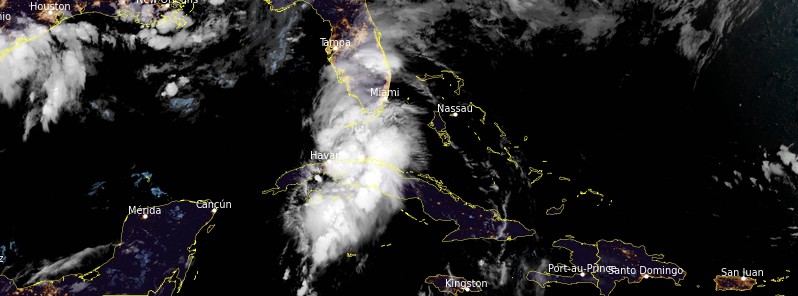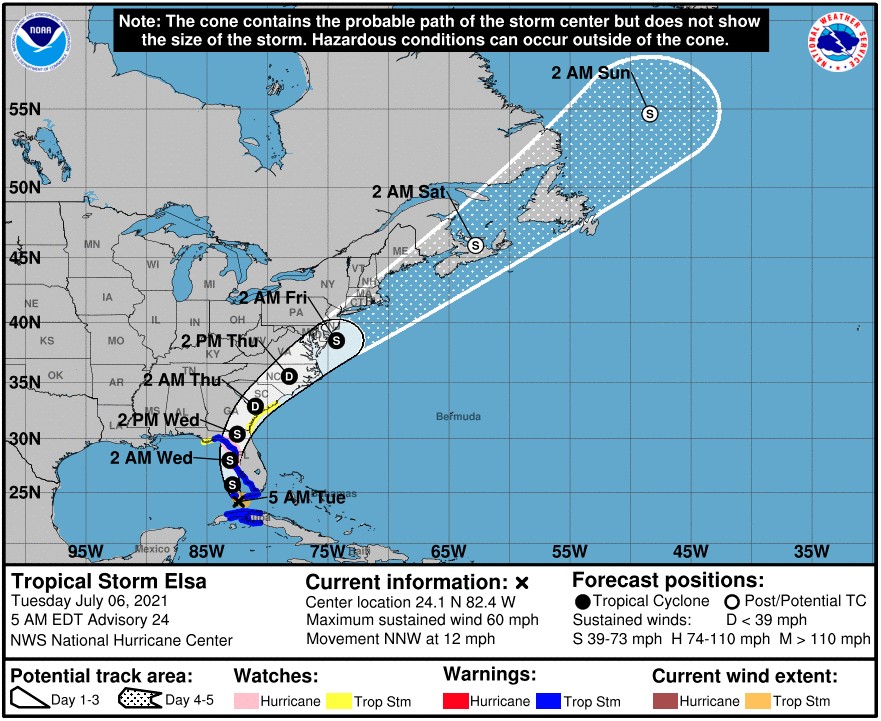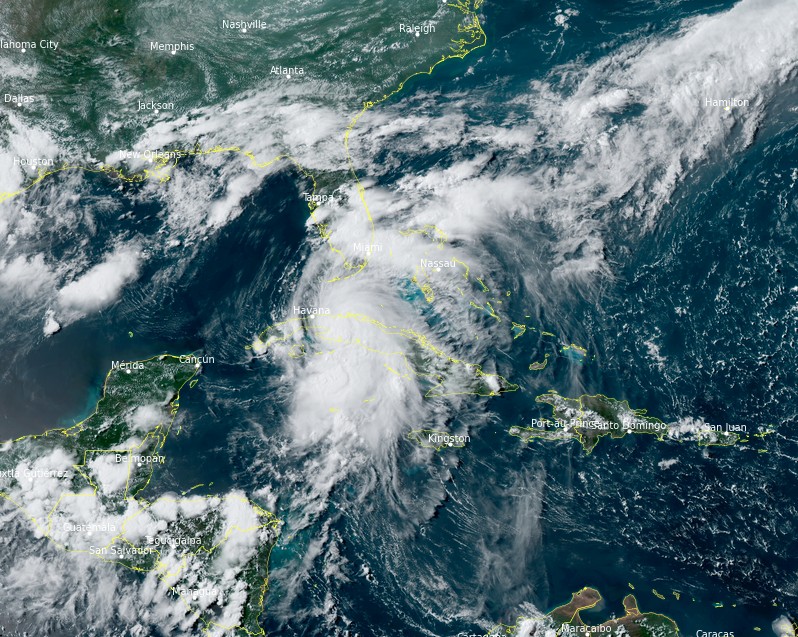Tropical Storm “Elsa” – Hurricane Watch issued for parts of Florida, U.S.

Tropical Storm "Elsa" is re-strengthening after moving over Cuba toward Florida, U.S. The system will pass near the Florida Keys this morning LT, July 6, and move near or over portions of the west coast of Florida later today and continuing into Wednesday, July 7, 2021.
At 09:00 UTC on July 6, 2021, the center of Tropical Storm "Elsa" was located over the Florida Straits — 80 km (50 miles) SW of Key West and 435 km (270 miles) S of Tampa, Florida.
Tropical-storm-force wind gusts are already occurring across the Lower and Middle Keys. Doppler radar data and satellite images indicate that the core of Elsa is fairly small and has maximum winds of around 95 km/h (60 mph).
Elsa was moving NNW at 19 km/h (12 mph) and had minimum central pressure of 1 007 hPa, according to the National Hurricane Center (NHC). This general motion is expected to continue today, followed by a turn toward the north by tonight (LT) and NNE motion on Wednesday.
On the forecast track, Elsa will pass near the Florida Keys this morning, and move near or over portions of the west coast of Florida later today and continuing into Wednesday.
Slow strengthening is forecast through tonight, and Elsa could be near hurricane strength before it makes landfall in Florida, NHC said. Weakening is expected after it moves inland.
The Air Force Hurricane Hunters will be investigating Elsa later this morning, and the data the plane collects will be valuable in assessing the storm's intensity and structure.
"The most recent July named storm landfall in the Florida Keys is Tropical Storm "Bonnie" (2010). Bonnie made landfall near Elliot Key," meteorologist Philip Klotzbach said.

- A Hurricane Watch has been issued for the west-central and Big Bend coast of Florida from Egmont Key to the Steinhatchee River at 09:00 UTC on July 6, 2021 (05:00 EDT).
- A Tropical Storm Watch has been issued for the Georgia coast and portions of the South Carolina coast from the Mouth of St. Marys River to South Santee River, South Carolina.
- A Storm Surge Warning is in effect for the west coast of Florida from Bonita Beach to the Aucilla River, including Tampa Bay.
- A Tropical Storm Warning is in effect for the Cuban provinces of Matanzas, Mayabeque, Havana, and Artemisa; and the Florida Keys from Craig Key westward to the Dry Tortugas, west coast of Florida from Flamingo northward to Ochlockonee River.
- A Storm Surge Watch is in effect for the west of the Aucilla River to the Ochlockonee River, Florida.
- A Tropical Storm Watch is in effect for the west of the Ochlockonee River to Indian Pass, Florida, and Mouth of St. Marys River to South Santee River, South Carolina.
Heavy rain will impact Cuba today resulting in significant flooding and mudslides. As Elsa moves across the western Florida Peninsula through Wednesday, heavy rainfall may result in isolated flash, urban, and minor river flooding, with considerable flash and urban flooding possible in southwest and western portions of Florida.
Mid to late week, heavy rainfall across coastal Georgia, South Carolina, North Carolina, and southeastern Virginia may result in isolated flash and urban flooding, with considerable flash and urban flooding possible across coastal Georgia and the Lowcountry of South Carolina.
There is a danger of life-threatening storm surge along portions of the west coast of Florida tonight and Wednesday, and a Storm Surge Warning is in effect for that area.

Tropical Storm "Elsa" at 21:00 UTC on July 5, 2021. Credit: NOAA/GOES-East, RAMMB/CIRA, TW
Tropical Storm "Elsa" formed at 09:00 UTC on July 1, becoming the earliest fifth-named storm on record, surpassing the previous record held by Tropical Storm "Edouard" of the previous year, which formed on July 6.
Elsa also became a tropical storm farther east in the Main Development Region (MDR) than any other tropical cyclone so early in the calendar year on record, behind only the 1933 Trinidad hurricane.
It slowly strengthened as it accelerated westward, and at 10:45 UTC on July 2, the NHC upgraded it to a Category 1 hurricane, making Elsa the eastern-most hurricane recorded in the MDR, south of 23.5°N, this early in the calendar year since 1933.
Around that time, Elsa was moving at a forward speed of 47 km/h (29 mph), making it the fastest-moving Atlantic tropical cyclone recorded undergoing rapid intensification in the deep tropics or the Gulf of Mexico, and also the first storm to undergo rapid intensification in that part of the Atlantic that early in the calendar year since another storm in 1908.
At 15:00 UTC on July 3, Elsa weakened back into a tropical storm, due to northeasterly wind shear, which was partially due to the storm's rapid forward motion at almost 48 km/h (30 mph).
Afterward, Elsa's forward motion significantly slowed down to 22 km/h (14 mph) on July 4, as its center relocated to the east under the region with the strongest convection, while passing just north of Jamaica.
At 18:00 UTC on July 5, Elsa made landfall near Cienega de Zapata, a natural park in west-central Cuba, with maximum sustained winds of 85 km/h (50 mph).
Cuba's meteorological institute – INSMET said Elsa passed through the island bringing winds of 100 km/h (62 mph) and some stronger gusts. Ahead of the landfall, Cuba ordered the evacuation of 180 000 people from its southern regions.
Up to 250 mm (10 inches) of rain was expected across parts of Cuba with up to 380 mm (15 inches) in some areas.
"The most recent July named storm (e.g., tropical storm or hurricane) landfall in Cuba is Hurricane 'Dennis' in 2005," Klotzbach said.
At 02:00 UTC on July 6, Elsa emerged into the Gulf of Mexico and began to re-strengthen.
The hardest-hit areas by this storm are Barbados, where more than 1 100 homes were damaged, including 62 that collapsed; St. Lucia, where one person was killed; the Dominican Republic, where two people died after walls collapsed on them; and Haiti, where three people were injured by downed trees.
Featured image: Tropical Storm "Elsa" at 10:10 UTC on July 6, 2021. Credit: NOAA/GOES-East, RAMMB/CIRA, TW

Commenting rules and guidelines
We value the thoughts and opinions of our readers and welcome healthy discussions on our website. In order to maintain a respectful and positive community, we ask that all commenters follow these rules.